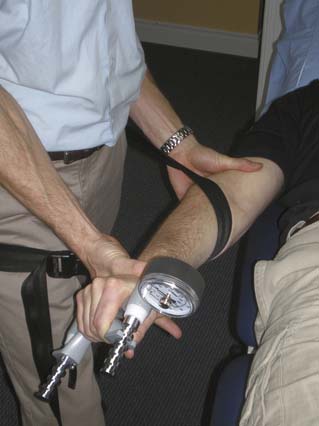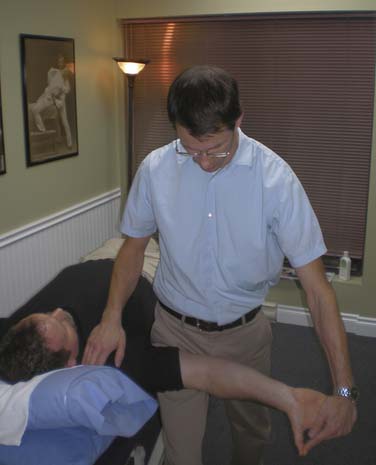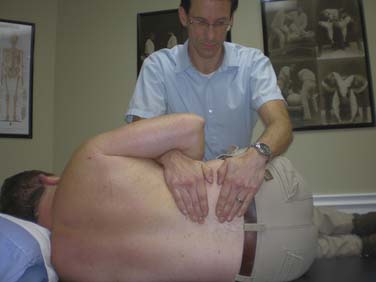48 Manual Therapy
Certainly many of our patients equate manual therapy exclusively with the manipulative thrust or high-velocity, low-amplitude (HVLA) maneuver practiced by clinicians in the diverse professions of physical therapy, medicine, chiropractic, osteopathy, naprapathy, traditional Chinese medicine, and naturopathy as part of their legislated scope of practice. However, manual therapy, in fact, also encompasses a great variety of other techniques. The American Physical Therapy Association (APTA) has defined manual therapy techniques as “skilled hand movements intended to improve tissue extensibility, increase range of motion, induce relaxation, mobilize or manipulate soft tissue and joints, modulate pain, and reduce soft tissue swelling, inflammation, or restriction”. Techniques matched with these proposed indications for manual therapy include massage, manual lymphatic drainage, manual traction, mobilization/manipulation, and passive range of motion (ROM).1 Although within physical therapy in the United States, defined synonymously as “a manual therapy technique comprised of a continuum of skilled passive movements to joints and/or related soft tissues that are applied at varying speeds and amplitudes, including a small amplitude/high velocity therapeutic movement”, more commonly the term manipulation is used to describe a thrust technique performed at a pathologic end of range of a joint, whereas mobilization describes a nonthrust, sustained or oscillatory, low-velocity movement within or at the end of range of joint motion.1 Additional specified manual therapy interventions include soft tissue and neural mobilization, joint stabilization, and self-mobilization exercises.2
History of Manual Therapy
Early Medicine
Manual therapy is among the oldest recorded interventions in medicine. Documentation of its practice dates back over 4000 years to Egyptian scrolls (Edwin Smith papyrus) and its use was also depicted in ancient Thai sculptures.3 The first mention of massage appears in the Nei Ching, the oldest existing medical work, dedicated to the Chinese Emperor Huang Ti in 2598 BC. Ancient Indian and Greek texts, including the work of Hippocrates, describe massage as an effective therapy for treating injuries resulting from war or sports.4 Hippocrates (460-385 BC) also described a combination of traction and manipulation on the back of a patient lying prone on a wooden bed in his treatise, On Setting Joints by Leverage.5 Whether Hippocrates solely attempted by this method to reposition traumatically displaced vertebrae or if he intended to manipulate slightly luxated vertebrae for a variety of indications, to this day remains a matter of debate.6 The Roman physician Galen (131 to 202) commented on Hippocrates’ techniques in 18 of his 97 surviving treatises, as did the influential Arabic physician Abu Ali ibn Sina, better known as Avicenna (980 to 1037). In 1656, Friar Thomas described manipulative techniques for the extremities in his book, The Complete Bone Setter, and in as late as 1674, Johannes Scultetus still included descriptions of Hippocrates’ manipulative methods in his text, The Surgeon’s Storehouse.7
Manipulation fell out of favor in medicine when Sir Percival Pott (1714 to 1788) described tuberculosis of the spine and condemned traction and manipulation as not only useless but dangerous.5–7 However, manipulation in the form of bone setting continued to be practiced with some of its lay practitioners attaining great notoriety including Sarah Mapp in 18th century and Sir Albert Baker in 20th century England, who both counted royalty among their patients. In the United States, the male members of the Rhode Island Sweet family were reputed to possess hereditary skills in bone setting. One of them, Waterman Sweet, in 1829 published a text called, An Essay on the Science of Bone Setting. Bone setting continues to be practiced today in large parts of the world by lay practitioners as a form of folk medicine.8
During this time, manual therapy in medicine was relegated to a number of fringe clinicians, foremost among them the 1784 Edinburgh University graduate Edward Harrison. Harrison published in the London Medical and Physical Journal on a proposed pathophysiologic connection between spinal subluxations and visceral disease and adjusted vertebrae by pressing on the spinous or transverse processes with his thumbs or with a device.5,6,9 In 1828, Glasgow physician, Thomas Brown, popularized in the medical community the concept of “spinal irritation”. Brown proposed that a shared nerve supply could implicate the spine in visceral disease and nervous conditions, which led him to target the spine with nonmanipulative heroic medicine interventions including local blistering, application of leeches, and cautery. Dr. Isaac Parrish of Philadelphia introduced the concept of spinal irritation in North America with an article on the topic in The American Journal of Medical Sciences.9,10 Riadore, a prominent London physician practicing manipulation, stated in 1842, “if an organ is insufficiently supplied with nervous energy or blood, its function is decreased and sooner or later its structure becomes endangered.5 With their theories acceptable even to many eminent 19th century medical physicians, it is easy to understand how first osteopathy after 1874 and then chiropractic after 1895 and its offshoots, naturopathy after 1902 and naprapathy after 1905, rapidly gained widespread acceptance among the American general population.
Early Physical Therapy
Meanwhile, there was also renewed interest from the medical community in manual therapy. In 1867, the British Medical Journal reported on a lecture by Dr. James Paget, On the Cases that Bonesetters Cure. In 1871, Dr. Wharton Hood wrote a series complementary to bone setting for the Lancet based on his experiences with a bone setter named Hutton, and in 1882 there was a discussion of bone setting at the 50th annual meeting of the British Medical Association.5,7 One reason for this renewed interest might have been the influx and successful establishment of thriving practices by the earliest Swedish-educated physical therapists in various countries, including the United Kingdom. Physical therapy as a government-sanctioned, university-educated profession began when, in 1813, in Stockholm Pehr Hendrik Ling (1776 to 1839) founded the Kungliga Gymnastiska Centralinstitutet or Royal Central Institute for Gymnastics (RCIG) in Stockholm.11 Students at the RCIG were either noblemen or belonged to the upper echelons of society; most were also army officers. They were instructed in physical education, military gymnastics (mainly fencing), and physical therapy or medical gymnastics. The medical gymnastics taught and practiced included a strong manual therapy component, leading Ottoson12 to describe physical therapy as the world’s oldest manual therapy profession (Figs. 48-1 to 48-3). Although, by today’s standards, the manual therapy component instructed in Ling’s system can hardly be called segment specific, clinicians educated at the RCIG certainly further developed and published more specific manipulative interventions.13
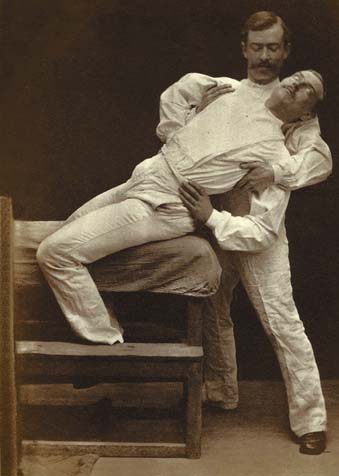
Figure 48-1 Lumbar mobilization ad modem Ling.
(Reproduced with kind permission from Dr. Anders Ottoson, National Archives of Sweden, http://www.chronomedica.se).
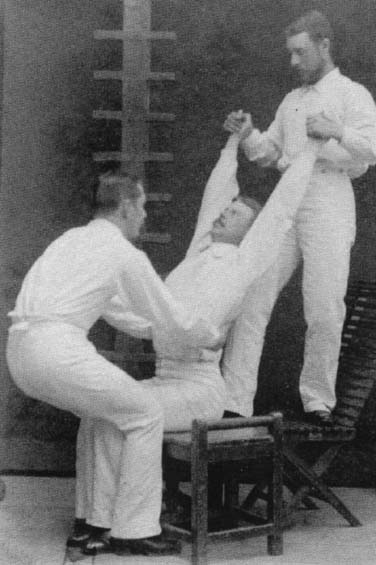
Figure 48-2 Thoracic traction ad modem Ling.
(Reproduced with kind permission from Dr. Anders Ottoson, National Archives of Sweden, http://www.chronomedica.se).
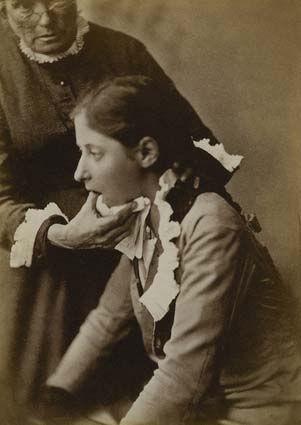
Figure 48-3 Temporomandibular joint mobilization ad modem Ling.
(Reproduced with kind permission from Dr. Anders Ottoson, National Archives of Sweden, http://www.chronomedica.se).
Empowered by their scientific training and propelled by an unwavering conviction that physical therapy could positively affect many conditions including (and thereby not unlike osteopathy and chiropractic) a multitude of nonmusculoskeletal pathologies, RCIG graduates traveled around the globe to disseminate their approach to patient management based on what they considered current best evidence. As early as the 1830s they started establishing clinics in many European cities. A great number of foreign doctors and laymen traveled to Stockholm to study physical therapy with Ling’s successor Lars Gabriel Branding (1799 to 1881). Meanwhile in Sweden, an 80-year turf war erupted between these early physical therapists and the fledgling orthopedic medicine specialization, from which the orthopedic physicians at the Karolinska Institute eventually emerged victorious.11,14 Physical therapy education in Sweden and eventually worldwide was restructured to a technical education producing allied health technicians. In English-language countries, physical therapy was often practiced by nurses with additional course work in massage and exercise therapy. In other Western European countries, physical education teachers with additional course work in rehabilitative exercise, often begrudgingly gave up their previous professional independence for support from the medical profession in their search for societal recognition.15
In rapid succession, national associations arose from these physical therapy technicians. In 1889 in the Netherlands, physical therapists founded the world’s first professional association, the Society for Practising Heilgymnastics in the Netherlands. In 1894, in Great Britain, the Society of Trained Masseuses was founded and in 1906 in Australia, the Australasian Massage Association.15,16 Physical therapy in the United States had a relatively late start with the founding of the American Women’s Physical Therapeutic Association in 1921. When the United States entered World War I, it did not, in contrast to its European allies, have a military with an established division of physical therapy. By command of the Surgeon General, a number of university physical education programs, instituted physiotherapy “War Emergency Courses” to train women who could physically rehabilitate returning soldiers. As a result, 90% of World War I physical therapists came from schools of physical education; in fact, the physician then in charge of the Army Physiotherapy Division stipulated that all therapists have 4-year university degrees in physical education in addition to their physical therapy training. When in 1922 the military reduced therapy services as a result of government cutbacks, many therapists previously employed by the military were forced into the private sector. This led to conflicts with other manual medicine practitioners including nurses, osteopaths, and chiropractors all claiming to practice physical therapy. It was this early conflict especially with the chiropractic profession that caused therapists to align themselves more closely with medical physicians. To garner physician support, U.S. physical therapists in 1930 voluntary relinquished their right to see patients without physician referral.17
In the United States, this close alliance with the medical profession and the adversarial relationship between physicians, and especially chiropractors, also had physical therapists in their communication with physicians deemphasize the use of manual therapy in their clinical practice—although these interventions continued to be used and further developed within the profession with various publications during this period in the U.S. professional physical therapy literature.18 In Western Europe and Scandinavia, this adversarial stance never developed. Instead, medical physicians embraced osteopathy, chiropractic, and other manual medicine approaches indigenous to Europe. Throughout Europe, postgraduate manual medicine training institutes were well attended by physicians and even academic chairs in manual medicine were established.19
These European physicians also educated their physical therapy technicians in manual therapy. Dr. James Mennell (1880 to 1957), the medical officer at St. Thomas Hospital in London, taught manipulation to physical therapists as of 1916. His son, Dr. John McMillan Mennell (1916 to 1992) educated physicians and physical therapists worldwide in manipulation and, with Dr. Janet Travell, cofounded the North American Academy of Manipulative Medicine. Dr. James Henry Cyriax (1904 to 1985), Mennell’s successor at St. Thomas, stated that physical therapists were the most apt professionals to learn manipulative techniques. Mennell is most known for developing and instructing therapists and physicians worldwide. His system of orthopedic medicine emphasized clinical diagnosis and conservative management by way of mainly friction massage, exercise, manipulation, and infiltration. Less well known is his link to early Swedish physical therapy, although his father (Dr. Edgar Cyriax 1874 to 1955), and his maternal grandfather (Jonas Henrik Kellgren 1837 to 1916), were both RCIG graduates. Another influential person teaching manipulation to therapists at this time at the London School of Osteopathy was Dr. Allan Stoddard, qualified in medicine and osteopathy. Therapists and physicians were also educated in manual therapy at the British School of Osteopathy as of 1920.7
Manual Therapy Approaches
Kaltenborn-Evjenth Approach
Without a doubt the most important person to again increase the emphasis on manual therapy within the profession of physical therapy was Norwegian-born Freddy Kaltenborn (1928-). Already trained as a physical education teacher he was admitted as the first male student to the Norwegian program in physical therapy in 1948. Educated in London in orthopedic medicine by Dr. James Cyriax from 1952 to 1954 and qualifying in chiropractic in Germany in 1958 and in osteopathy at the London School of Osteopathy with Dr. Stoddard in 1962, Kaltenborn -from 1968 on associated with physical therapist Olav Evjenth—developed an eclectic manual therapy system known as the Kaltenborn-Evjenth approach.14 With Kaltenborn the first clinician to apply the new science of arthrokinematics to manual therapy,7 central to the Kaltenborn-Evjenth approach is the emphasis on restoration of the gliding component of a normal joint roll-gliding movement. Also central is the concept of a treatment plane defined as the plane across the concave joint surface. With manual translatoric techniques defined in this system as encompassing traction, compression, and gliding techniques, traction and compression are performed perpendicular to this treatment plane, whereas gliding techniques induce movement parallel to this plane. Mobilization and manipulation techniques are used to reduce pain and increase ROM. Joint restrictions are classified as periarticular, articular, intraarticular, or combined in etiology. Periarticular restrictions owing to adaptive shortening of neuromuscular and inert structures (including skin, retinacula, and scar tissue) and articular structures (capsule and ligaments) are treated with sustained mobilization techniques, whereas periarticular restriction due to arthrogenic muscle hypertonicity is managed with neurophysiologic inhibitory techniques including thrust techniques.20 Intraarticular restrictions are best treated with (traction) manipulation initiated from the actual resting position.21
Maitland (Australian) Approach
In Australia, physical therapist Geoff Maitland (1924-) after studying abroad with Cyriax and Stoddard and physical therapists Gregory Grieve and Jennifer Hickling developed his own approach and started teaching a manual therapy system at the University of Adelaide in the entry-level physical therapy program. The world’s first 3-month certificate program was offered in 1965. In 1974, 12-month postgraduate diploma courses in manipulative therapy were offered at physical therapy programs in Australia. This approach to manual therapy is now referred to as the Maitland or Australian approach.22 Although it is often associated with variations of the nonthrust posteroanterior pressure technique (Fig. 48-4), the Maitland system uses a whole spectrum of thrust and nonthrust techniques. Perhaps its greatest contribution is its emphasis on structured clinical reasoning. History-taking is used to gather information that is used in the subsequent physical examination to establish the patient’s concordant or comparable signs. A concordant sign consists of pain or other symptoms reproduced on physical examination that are indicated by the patient as a chief complaint or reason to seek therapy.23 A thorough history-taking allows the clinician to distinguish between concordant and discordant signs. Discordant signs are findings on physical examination seemingly implicating a source of symptoms that are, however, in no way related to the chief complaint.24 Unique to the Maitland approach are also the frequent immediate postintervention reevaluations of the deemed most relevant concordant or so-called asterisk signs to guide further management.
Paris Approach
In 1960, physical therapist Stanley Paris from New Zealand received a scholarship from the New Zealand Workers Compensation Board to study with Freddy Kaltenborn and Allan Stoddard. On his return to New Zealand, he organized courses and introduced, among others, later influential physical therapists Robin McKenzie and Brian Mulligan to manual therapy before leaving to teach and practice in the United States. Paris became the voice of manual therapy as a specialization within orthopedic physical therapy within the United States and worldwide. Denied access—for being a physical therapist and not a physician—to the North American Academy of Manipulative Medicine by Dr. Janet Travell, he founded the North American Academy of Manipulative Therapy in 1968, which was disbanded in 1974 to become the Manual Therapy Special Interest Group in Canada and the Orthopedic Section of the APTA in the United States. Together with, among others, physical therapists Grieve, Kaltenborn, Lamb, and Maitland, Paris also founded in Montreal in 1974, the International Federation of Orthopaedic Manipulative Therapists (IFOMT), the first recognized subgroup of the World Confederation of Physical Therapy. At the urging of Kaltenborn, Paris was again involved in 1991 in organizing the American Academy of Orthopedic Manual Therapy.5,7,14 Most relevant to U.S. physicians referring for manual therapy is that fellows in this organization (designated FAAOMPT) have demonstrated advanced proficiency in manual therapy skills and knowledge. Paris also developed an eclectic system of manual therapy. In addition to a unique diagnostic classification system, and central to this system, is the emphasis not on addressing pain but on treating dysfunction defined as a state of altered mechanics, either an increase or decrease from the expected normal, or the presence of an aberrant motion.25
Mechanical Diagnosis and Therapy: McKenzie Approach
Although emphasizing patient independence by way of specific exercise self-treatment, physical therapist Robin McKenzie of New Zealand has developed a strongly research-based approach to management of spinal and extremity conditions called the McKenzie or Mechanical Diagnosis and Therapy (MDT) approach that incorporates examination and treatment by way of sustained and repeated movements and, if required, mostly nonthrust manual therapy interventions. Classification into postural, dysfunction, or derangement syndromes is guided by patient report of pain during repeated movement examination occurring within range or at end range and by the possible occurrence of centralization and peripheralization. Unique to the MDT concept and indicative of the derangement syndrome—strongly associated in the spine with discogenic dysfunction—centralization is defined as “the situation in which pain arising from the spine and felt laterally from the midline or distally is reduced and transferred to a more central or near midline position when certain movements are performed”. Peripheralization describes the opposite condition, whereby movements cause pain to be felt more distally or laterally from the midline.26
Mulligan Approach
New Zealand physical therapist Brian Mulligan suggested minor positional faults as an etiology for joint dysfunction thought to respond to a unique manual therapy intervention called mobilizations with movement (MWM).27 With an MWM, the therapist applies a sustained accessory glide, long-axis rotation, or combination while the patient actively performs a previously, but now no longer painful, movement (Fig. 48-5). The Mulligan approach shares with the Kaltenborn approach an emphasis on restoration of the gliding component of the normal joint roll-gliding movement.28 Central to both is also the concept of the treatment plane but, whereas Kaltenborn emphasizes gliding techniques in the direction normally associated with the restricted physiologic motion, Mulligan often starts with a sustained glide at a right angle to this physiologic glide. An iterative process then tests glides in different directions or long-axis rotation before settling on the most effective direction allowing for pain-free active ROM or isometric muscle contraction, together constituting the MWM.28,29 Although Mulligan’s NAGs or natural apophyseal glides, mid to end-range facet joint mobilizations applied anterosuperiorly along the treatment plane, are perhaps less unique, the SNAGs or sustained natural apophyseal glides that combine active movement with therapist-applied mobilization certainly are. The techniques are supported by a home program of self-mobilization and corrective taping.27
Neural Mobilization
Based to a large extent on pioneering work by Breig,30 Australian physical therapists Robert Elvey, David Butler, and Michael Shacklock have contributed greatly to our understanding of the possible role of impaired neural mobility in the etiology of neuromusculoskeletal dysfunction.31,32 Also used in diagnosis, interventional neural mobilization techniques attempt to restore normal neural mobility or neurodynamic function in relation to the structures surrounding the nerve by inducing stretch or tension in the affected nerves or by mobilizing the surrounding tissues (Fig. 48-6).2 Butler has more recently expanded on this approach by integrating new insights with regard to pain physiology.33
Other Manual Therapy Systems: Canadian, Grimsby, and Dutch Approaches
Other manual therapy systems relevant mostly to North America include eclectic systems such as the Grimsby, Canadian, and Dutch manual therapy approaches. The Grimsby approach developed by Norwegian physical therapist Ola Grimsby and the Canadian approach initially developed by Canadian and English physical therapists David Lamb, Erl Pettman, Cliff Fowler, Jim Meadows, Ann Hoke, and Diane Lee are derived mainly from the Kaltenborn-Evjenth approach but continue to be developed into progressively more distinct systems of diagnosis and management.34–39 Most characteristic of the Grimsby approach is its emphasis on very specific exercise progressions. The Canadian approach (and its U.S. counterpart instructed at the North American Institute of Orthopaedic Manual Therapy or NAIOMT) emphasizes the use of screening examinations to guide further examination and diagnosis. The Dutch manual therapy system40 combines various manual therapy approaches developed within medicine, physical therapy, chiropractic, and osteopathy and bases diagnosis and management greatly on assumptions with regard to three-dimensional motion behavior of joints and on extrapolations related to somato-somatic and somato-autonomic neuroanatomic connections.
Massage and Soft-Tissue Mobilization
Although often erroneously associated with Pehr Hendrik Ling, Swedish massage was again popularized in the late 19th century as a viable medical treatment by Dr. Johan Georg Mezger (1838 to 1909), a Dutch physical education teacher turned physician.15 Also called traditional or —when applied to athletes—sports massage,41 most therapists do not consider Swedish massage a systematic manual therapy approach but rather a preparatory modality consisting of effleurage or rhythmic stroking hand movements, petrissage or kneading, tapotement or manual percussive massage, friction or deep penetrating pressure delivered through the finger tips, and vibration or shaking.4
James Cyriax promoted deep friction massage transverse to the fiber direction for the treatment of ligament and tendon injuries3 and from this various instrumented-assisted versions have developed including most prominently Graston technique and ASTYM (assisted soft tissue mobilization). The ASTYM method was developed by sports physician Dr. Tom Sevier, who not only has taken great care to investigate and support the method with basic and applied research evidence but who has also created a national outcome database to help therapists establish a research-based prognosis. Unlike Graston technique, initially marketed by Dr. Sevier’s former instrument maker, Mr. Dave Graston, ASTYM is not simply an instrument-assisted locally applied cross friction technique but is used to treat the whole kinetic chain involved with established protocols that are adapted by the clinician based on patient presentation (Fig. 48-7).

Figure 48-7 Assisted soft tissue mobilization (ASTYM) treatment for lateral epicondylalgia.
(Reproduced with kind permission from Dr. Tom Sevier, www.astym.com).
As do bodywork therapists, physical therapists also use soft-tissue mobilization, which includes techniques intended to affect muscles and connective tissues such as stretching, myofascial release, trigger point techniques, and deep tissue techniques.2 Myofascial release and deep tissue techniques are discussed in more detail in the chapter on bodywork and movement therapies. Active release technique (ART) is a form of deep tissue technique developed by the chiropractor P. Michael Leahy. In ART, protocols based on symptom patterns are linked to manual treatment of specific anatomic sites. Specific techniques are then used for release of proposed soft tissue adhesions that consist of applying deep digital tension, usually with the thumb or two fingers combined with both active and passive passage of the tissue through this area of deep tension. An active home stretching program follows this manual treatment.42
Stretching techniques performed by therapists in the context of manual therapy intervention can take the form of static or facilitated stretching. In the 1950s, physical therapists Margaret Knott & Dorothy Voss43 developed proprioceptive neuromuscular facilitation (PNF) that by way of a combination of isometric contractions and mid through end range movements in three-dimensional naturally occurring spiral and diagonal patterns used reflexogenic activation and relaxation for specific stretching, strengthening, and stabilization. Postisometric relaxation is a European manual medicine technique similar to a PNF hold-relax-stretch technique in that the patient is asked to gently contract a muscle from a slightly lengthened position followed by a further gentle stretch on relaxation.44
Manual trigger point therapy is an intervention often used in physical therapy. In the late 1930s, Dr. Janet Travell, at that time a cardiologist and medical researcher, became interested in muscle pain. In the early 1960s, physiatrist Dr. David Simons and his wife, physical therapist Lois Simons, started collaborating with Travell, which eventually resulted in the Trigger Point Manuals, consisting of two volumes on the upper and the lower half of the body.45,46 Although initially, in addition to spray-and-stretch techniques, heavy ischemic pressure was advocated as a manual technique for treatment of myofascial trigger points, the updated second edition of the first volume instead suggested the use of gentle digital pressure or trigger point pressure release.47
Physical therapists sometimes use other systems of massage and soft tissue mobilization that propose effects beyond those solely on the neuromusculoskeletal system. Those include, but are not limited to, Japanese Shiatsu acupressure massage, connective tissue massage, and Rolfing.48,49 Acupressure massage uses a rationale for management choices that is consistent with that used for acupuncture in traditional Chinese medicine. Connective tissue massage was developed by German physical therapists Elisabeth Dicke and Hede Teirich-Leube and physician W. Kohlrausch. In 1929, Dicke had serious endarteritis obliterans and amputation of her leg was considered. Noticing an increased tension in the skin and subcutaneous tissue of her lumbosacral region, she attempted to reduce the discomfort there by applying a stroking massage. She not only noted a sharp local sensation, but also itching and a feeling of warmth spreading into her affected leg. Continued self-treatment resulted in improvement of her ischemic complaints. Connective tissue massage is a reflex therapy that uses a manually applied shear force at connective tissue interfaces in the skin. This has been proposed to stimulate autonomic nerve endings, thereby restoring balance between the sympathetic and parasympathetic components of the autonomic nervous system. By way of cutaneovisceral responses evoked in segmentally related skin areas, this form of massage has also been hypothesized to affect internal organ function.49–51 Manual lymphatic drainage is a light-touch massage technique combined with patient education and compressive garments developed in the 1930s in France by the Danish psychologist Dr. Emil Vodder. It is primarily intended to have an effect on soft tissue edema.52
Mechanical Effects
Although it is not possible to separate mechanical and neurophysiologic effects in clinical research, disruption of articular and/or periarticular adhesions, release of entrapped synovial folds or plicae, reduction of displaced nuclear fragments, and unbuckling of motion segments have all been suggested as mechanical effects of thrust techniques.53 Peak force magnitudes used during spinal thrust techniques easily exceed body weight and are attained within 100 to 200 msec.54 Increased strain rates with thrust techniques lead to increased stiffness in collagenous tissues, possibly resulting in failure or disruption of adhesions with decreased joint excursion when compared to low-velocity techniques. Alternatively, mobility restrictions owing to collagenous shortening, fibrosis, or hyperplasia would likely benefit more from the viscoelastic deformation produced by sustained or oscillatory nonthrust articular and soft tissue techniques.53
The synovial fluid is composed of 15% suspended gases, 80% of which is carbon dioxide and the rest mainly oxygen and nitrogen. Thrust techniques cause a rapid distraction of the joint cavity resulting in a similarly rapid drop by some 3.5 atmosphere in intraarticular pressure. Although the joint will unsuccessfully try to adapt with invagination of capsular tissue into the joint cavity, the sudden local reduction of pressure will cause a process called cavitation whereby the previously suspended gases are released from solution and form a gas bubble within the joint. The cavitation process itself or the subsequent collapse of this gas bubble is what causes the audible release that often accompanies thrust techniques.55 Manipulation of a joint is followed by a refractory period of some 15 to 30 minutes during which the gas is again reabsorbed into the synovial fluid and no new cavitation can be produced.56 The joint distention due to the presence of nonsuspended gases in the synovial fluid during this period has been hypothesized to result in viscoelastic deformation of restricted capsuloligamentous structures.57
Although the traction component of thrust techniques seems a plausible mechanism for unbuckling or restoring appropriate alignment of displaced joint partners, research has not supported this proposed mechanism.53 Similarly, research so far has also failed to support the minor positional fault mechanism postulated by Mulligan.29 Evans53 suggested that release of entrapped synovial folds or inclusions is also unlikely and proposed neurophysiologic effects on persistent associated muscle spasm after such a mechanical event had occurred and spontaneously resolved.
Cyriax58 suggested that manipulation might restore displaced nuclear fragments to a more central location within the intervertebral disc (IVD). However, although various case reports have described positive effects of thrust techniques on carefully selected patients with IVD lesions,59 others have suggested that positive outcomes may be more related to natural history than to a mechanical effect of the manipulation. In fact, manipulation of a segment with a disc affected by trauma or degeneration, especially a noncontained herniation where the outer annulus is compromised, might lead to further injury, extrusion, and progressive neurologic compromise.60 In contrast to the equivocal mechanical effects of thrust techniques of the IVD and as initially proposed by McKenzie26 as a mechanical explanation for the effect of repeated movements, research on asymptomatic human subjects does show movement of the nucleus of the lumbar IVD anteriorly with extension and posteriorly with flexion in nondegenerated discs.60 Although research on symptomatic subjects is limited, Donelson and coworkers61 have shown the ability to differentiate with repeated movement testing between patients with a competent and noncompetent outer annulus suggesting similar mechanical effects in degenerated discs.
Friction massage has been hypothesized to stimulate tissue healing by way of local mechanical effects. Research has indeed shown cellular responses in the sense of increased fibroblast recruitment and activation and mechanical responses indicative of accelerated tissue healing with instrument-assisted deep friction massage.62–64 Swedish or sports massage has been hypothesized—although it is unclear whether this effect is mediated mechanically or neurophysiologically—to affect muscle tissue healing and recovery. However, a review on this topic showed limited and conflicting evidence for effects of massage on muscle blood flow and indicated that an effect of massage on lactate clearance was unlikely. Massage did result in significant decreases in delayed-onset muscle soreness (DOMS) but again, the evidence for an increased rate of post-DOMS force recovery—possibly indicative of accelerated muscle repair processes due to massage—was limited. There was also insufficient evidence for the effects of massage on recovery from muscle fatigue, although a trend was noted for endurance more so than strength performance.41
Neurophysiologic Effects
To this day, in some approaches to manual therapy, mechanical explanations for the mechanism of action of manual therapy interventions are considered more relevant than neurophysiologic explanations. However, the firmly held convictions that clinicians are able to apply segment-specific interventions and that such specific interventions are always required for optimal patient outcome, have not been supported by the available research. Segmental specificity is a biomechanical impossibility when applying the central posteroanterior pressures associated with the Maitland system. In the lumbar spine, for example, posteroanterior pressures resulted in motion of the entire lumbar region,65,66 whereas in the cervical spine, the same technique produced minimal, if any, intervertebral motion when applied at C2 or C6.67 Beffa and Mathews68 noted an equal distribution of cavitation induced from the sacroiliac to the L3-4 joints with thrust techniques aimed at either the sacroiliac or the L5-S1 joints. Ross and associates69 noted that manipulation of the lumbar and thoracic spine produced cavitation at the targeted joint only about 50% of the time; however, most procedures resulted in multiple cavitations, thereby including the target segment. Reggars70 showed that a thrust technique directed at C3-4 resulted in multiple-level cavitations in 82% of subjects, showing the lack of segmental specificity also for this cervical technique.
With regard to the need for specificity of the manual therapy technique for optimal results, Chiradejnant and colleagues71 noted no between-group differences on any of the outcome measures used in a group of patients with low back pain (LBP), who were treated with either unilateral or central posteroanterior or transverse pressures that had been selected by the therapist based on examination findings or randomly generated. In a case series, Cleland and colleagues72 noted favorable outcomes in patients who fit a prediction rule for sacroiliac joint manipulation in LBP, even though they were treated with a rotational technique aimed at the lumbar spine. Van Schalkwyk and Parkin-Smith73 found no between-group postintervention differences in patients with mechanical neck pain and segmental restriction when using either a rotational or lateral break manipulation technique. In their systematic review of randomized controlled trials investigating manual therapy for patients with nonspecific LBP, Kent and associates74 noted that studies in which the clinician was not given the choice of treatment technique actually had better short-term outcomes with regard to pain and activity limitation than those studies in which the clinicians were given a treatment choice; long-term outcomes were equal in both types of studies. Haas and colleagues75 showed that there were no short-term between-group differences in pain and stiffness ratings when patients with neck pain were manipulated at a segment with decreased segmental mobility or at a randomly generated segment. Although this research evidence in no way disproves the notion that for some patients specific manual therapy interventions will, in fact, provide better outcomes, it does indicate the need for all clinicians to more seriously consider possible neurophysiologic mechanisms of action for manual therapy interventions.
Input for neurophysiologic effects of manual therapy likely occurs by stimulation of cutaneous, musculotendinous, and capsuloligamentous receptors. Stimulation of thick fiber afferent neurons might explain analgesia by way of activation of the gate control mechanism postulated by Melzack and Wall.76 The persistent postcavitation distention of the joint capsule has been hypothesized to cause depolarization of the thick fiber afferent type III articular mechanoreceptors with resultant inhibitory effects on periarticular muscles.57 Massage has been shown to reduce motor neuron excitability as measured by a decreased H-reflex in both neurologically normal subjects and in subjects with spinal cord injury.77–79 Although Herzog54 suggested this was due to an artifact related to positional changes, manipulation research has produced similar decreases in motor neuron excitability in healthy subjects that were even more pronounced in subjects with chronic pain.2 Of course, we cannot exclude supraspinal influences as causing or contributing to this decreased motor neuron excitability but, considering the seemingly increased motor neuron excitability related to those higher-level systems discussed subsequently, this reduction in excitability would seem caused by segmental mechanisms.
Because of the synaptic connections between low-threshold joint and muscle mechanoreceptors, the dorsal periaqueductal gray (PAG) area of the midbrain may also have a role in manipulation-induced analgesia by way of descending inhibitory mechanisms. This PAG plays an important integrative role with regard to the response to stress, pain, and other stimuli by coordination of the nociceptive, autonomic, and motor systems. Its hypothesized role has been supported by manipulation studies showing sympathoexcitation and central postmanipulation motor facilitation—the latter also evidenced by muscle activation remote from the area of manipulation occurring some 50 to 200 msecs after manipulation.54,80,81 The ventrolateral PAG exerts its descending inhibitory influence by way of an opioid mechanism but research has been equivocal when it has come to detecting elevated plasma beta-endorphin levels after manipulation or massage. Similarly, intravenously administered opioid antagonists have not been shown to reverse the hypoalgesic effect of at least nonthrust manual therapy interventions.82 Although one can question relevance of plasma samples to extrapolate regarding the central role of endorphins in manipulation-induced analgesia with endorphins too large to penetrate the blood-brain barrier, recently the endocannabinoid system has been suggested as relevant to the analgesic but also mood-enhancing effects of manual therapy interventions.83,84
Animal research has also indicated a role for the neuropeptide oxytocin in the plasma and in the PAG in the analgesia produced by massage. Blockade of the oxytocin receptors either in the PAG or systemically was shown to reduce the analgesic effects of massage. Massage in human subjects has been shown to decrease cortisol and increase serotonin levels.2 Animal research also has implicated central mechanisms working by way of serotonin and norepinephrine in the analgesia produced by nonthrust joint mobilization but no role for gamma-aminobutyric acid (GABA) or endogenous opioids.85
Psychological Effects
Massage has also been shown to have significant positive effects on mood states including depression and anxiety in various patient populations.86–90 Whether this is a psychological effect or whether it is mediated by endogenous opioid or endocannabinoid, actions related to descending inhibitory systems is unclear. For thrust techniques, the occurrence of an audible release due to cavitation has been suggested as relevant to the patient experiencing a psychological therapeutic effect.57 Preliminary evidence, however, suggests that occurrence or nonoccurrence of this phenomenon has no effect on the short-term outcome with regard to pain, function, or ROM in patients with mechanical LBP91 or neck pain92 and on 4-week outcomes in patients with LBP.93
Examination and Diagnosis
Manual Therapy Examination
Even though research has generally not shown these tests to be reliable or valid,94 positional palpation tests to establish the presence of possible malposition related to joint dysfunction are still advocated and used within some manual therapy approaches. Palpation for changes in tissue texture thought to be indicative of segmental dysfunction have shown some interrater reliability but abnormalities are found in symptomatic and asymptomatic subjects indicating likely limited diagnostic value.
Joint play tests assess for ROM, symptom reproduction, resistance through range and at end range (the latter also known as end feel), and overall impression during passive accessory motion testing of the extremity joints. Various types of motion palpation tests (Table 48-1) assess for similar qualities in the spine and sacroiliac joints (Figs. 48-8 and 48-9). Intrarater agreement for isolated spinal motion palpation tests varies from less than chance to generally moderate or substantial agreement, whereas interrater agreement only rarely exceeds poor to fair agreement. Rating scales for mobility are less reliable than rating for pain. Given the neurophysiologic mechanisms of action described for manual therapy and the lack of a need, in at least some patients, for segmental specificity of the manual therapy intervention, knowing there is a joint dysfunction may be more relevant than knowing the exact location and direction of the dysfunction. Thus, even less reliable tests might provide appropriate guidance for manual therapy management.95 In contrast to data on isolated tests, pragmatic combinations of various motion palpation tests left to clinician discretion have shown high predictive validity for pain relief with zygapophyseal infiltrations in the cervical and lumbar spine.96,97
Table 48-1 Types of Spinal Motion Palpation
| Type of Palpation | Description |
|---|---|
| Active motion palpation | Assessment technique in which the clinician palpates bony landmarks while guiding the patient through cardinal plane motions of the trunk |
| Passive motion palpation | Assessment technique whereby one vertebra is moved in physiologic ranges on another (PPIVM) |
| Assessment technique whereby segmental mobility is assessed through the translatory motions associated with physiologic motions (PAIVM) | |
| PAIVM tests that specifically test for accessory motions that should not or minimally be present in a normal motion segment (PAIVM) |
PAIVM, passive accessory intervertebral motion palpation; PPIVM, passive physiological intervertebral motion palpation.
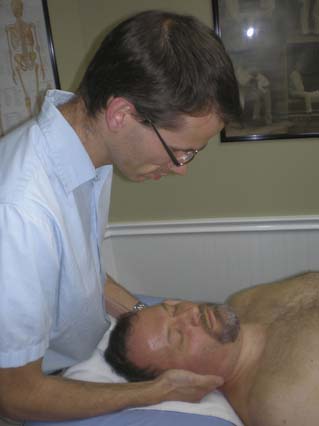
Figure 48-9 Passive physiologic intervertebral motion (PPIVM) test for segmental unilateral cervical extension.
Provocation tests have more consistently demonstrated sufficient reliability and diagnostic accuracy.94 Laslett and coworkers23 studied concurrent criterion-related validity of a comprehensive examination consisting of an MDT repeated movement evaluation combined with a cluster of SIJ provocation tests including the distraction, compression, thigh thrust, pelvic torsion, and sacral thrust tests. The rating scale for the individual tests was dichotomous; the subjects were diagnosed with SIJD when three or more tests were positive after exclusion of discogenic complaints with the repeated movement evaluation. The gold standard test was a fluoroscopically guided double SIJ block with at least 80% pain reduction. The authors reported positive LR of 6.97 (95% CI 2.70 to 20.27) and a negative LR of 0.11 (95% CI 0.02 to 0.44). Excluding the discogenic patients yielded a positive LR of 4.16 (95% CI 2.16 to 8.39) and a negative LR of 0.12 (95% CI 0.02 to 0.49).
Acknowledging the relevance of clusters of tests rather than isolated tests in clinical reasoning and patient management, recent research within manual therapy has emphasized the development and validation of clinical prediction rules. Clinical prediction rules (CPR) are decision-making tools that contain predictor variables obtained from patient history, examination, and simple diagnostic tests; they can assist in making a diagnosis, establishing prognosis, or determining appropriate management.98 As Childs and Flynn99 pointed out, if studies included in a systematic review or meta-analysis use no patient classification other than the broad category of nonspecific low back (or neck) pain, the resultant heterogeneous study samples likely preclude finding real effects of any intervention. CPR research is one method to identify a more homogeneous diagnostic subgroup of patients that is expected to respond to manual therapy intervention. Relevant CPRs are discussed under treatment-based diagnostic classification.
Diagnostic Classification in Manual Therapy
Findings from the history and physical examination (and possibly data from imaging and additional medical diagnostic data) are evaluated to establish a manual therapy diagnosis. Diagnosis is classification of patients based on predetermined defining characteristics and as such, diagnosis requires a classification system that, to be useful for manual therapy diagnosis within physical therapy, must meet the following criteria1:
Stay updated, free articles. Join our Telegram channel

Full access? Get Clinical Tree



